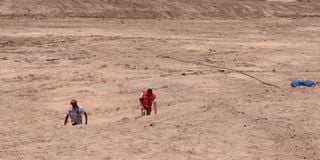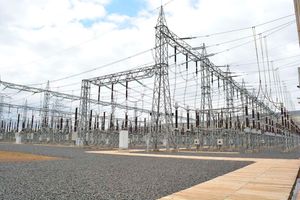What next for counties grappling with drought?

An empty water pan in Afwein village, Garissa County. NDMA has raised concern over the worsening drought situation in the country, with seven counties now at the drought alarm stage.
What you need to know:
- Poor agricultural methods such as overstocking contributes to negative climatic conditions.
- Pastoralist communities in the country pride themselves in keeping large herds of animals. In Afwein village, they call it mali, translated to wealth.
If drought had a face, only coerced people would wish to look at it twice. The faces of Kenyans who are drought-stricken are accompanied by tales of resigning to nature’s fate and the long wait of hope that seems obscure.
Healthy Nation team finds 61-year-old Hussein Aden lazed in front of the only shop in Afwein village, Garissa County.
There is a mild sand storm, one that makes the eye feel like someone is deliberately throwing shards of glass in them. The sweltering heat pierces through the head.
Aden leads us to a makeshift house due to the strong winds that keep distracting our conversation. In the house, there is a temporary lesso that acts as a windbreaker.
Here, locals are living in the reality of the effects of climate change. For three years, the sound of rain drops has remained an imagination.
At Aden’s village, there is no source of water. They solely depend on water boozers that sell 20 litres of water at Sh50. Aden and other members of his community are pastoralists who have to get water for human and animal use.
“I have lost count of the cows I have lost in the last three years. I had quite a number but they are all dead. It is hard to find water and food,” he says.
“This is the worst drought we have experienced ever since I was born,” he adds.
Halima Korane, an inhabitant of Afwein village, echoes Aden’s assertion of the worst-case-scenario kind of drought.
“When I was young, our family still practised pastoralism. We could get rain often. We could migrate from place to place. When I grew up, I moved to Afwein so that my children could get education, but I have never experienced drought as bad as this,” she says.
A few metres from the town centre is a water pan that has never sniffed the smell of water since it was dug.
Even as the people of Afwein village and millions of Kenyans living in the drought-stricken Arid and Semi-Arid lands grapple with the effects of Climate change, most of them do not even know what climate change is. Climate change lingo such as mitigation, adaptation, loss and damage; which they either need or are experiencing, remains Greek to them. “If we miss the rain, we solely depend on God. He gives and takes life, if our animals die, we will die as well,” says Korane.
This comes less than 70 days to a global climate change meeting dubbed the 27th Conference of Parties (COP27) that will be held in Sharm El Sheikh, Egypt this year.
In an article published by the United Nations, the chair of the African Group of Negotiators on climate change, Ephraim Mwepya Shitima of Zambia, reinforced the need for mitigation and adaptation as a key issue to be discussed in Egypt.
“COP27 should be about advancing the implementation of the National Determined Contributions including adaptation and mitigation efforts and delivery of finance to enhance implementation. COP26 concluded the remaining guidance on implementing the Paris Agreement on climate change, therefore we need to advance the implementation of our climate actions,” he said.
Experts, however, think that education on climate change is a missing link.
Last month, the Council of Governors launched a curriculum to teach climate scientists in counties on how best to manage financial resources directed to tackling climate change.
Saiyana Lembara, director of technical services for the National Drought Management Authority-Nairobi, said during the launch that awareness creation is an important tool for fighting climate change.
“With awareness, we believe that we can prepare better and also handle situations better. Counties that are prone to drought are also flood-prone regions. We therefore have to enhance our adaptive capacities by increasing awareness at various levels, from the community to leadership so that when a crisis arises we can all respond accordingly,” he said.
Dr Kinyanjui Koimbori, climate change expert and founder of Climate Change Kenya, offers solutions to help tackle the biting drought, which he says are either naturally or human-driven.
But first, what causes drought?
“Drought comes about when there is a reduced rainfall over a long period of time. Usually, rain falls after a complete hydrological cycle (it occurs when water passes into the atmosphere as water vapor, comes back to the earth in liquid or solid form and ultimately returns to the atmosphere through evaporation). When that cycle is distorted, then we are likely to experience drought,” he explains.
Dr Koimbori explains that human factors such as deforestation aggravate climate change, one that Healthy Nation team observed is an alternative source of livelihood in areas affected by drought as residents cut down trees for charcoal trade.
He adds that poor agricultural methods such as overstocking contributes to negative climatic conditions. Pastoralist communities in the country pride themselves in keeping large herds of animals. In Afwein village, they call it mali, translated to wealth.
“Cattle and camels, which are ruminants, release a lot of methane gas when they chew curd. This leads to an increase in surface temperature. The more the cows, the likelier more grass will be eaten up. This in turn contributes to the degrading of vegetation cover and contributes to soil erosion.”
Dr Koimbori suggests solutions to the drought experienced in the ASAL regions, most of which use technology, but warns that they are expensive.
“Cloud seeding is one such example. This is being used in the Arab countries, which also have very high temperatures. This is where an aeroplane goes into the clouds and releases some electric current that helps in binding particles closer, which in turn causes rain.
“Another solution that has been used in other countries is the introduction of water vapour into the sky so that it forms clouds. At the same time, they release steam from underground and then the rain pours,” he adds.
Mr Ramaphosa notes that it is still of concern that the necessary financial flows to enable developing economy countries in particular to mitigate and adapt to the impacts of climate change remain vastly inadequate.
The cheaper and natural means of tackling drought take time to be effective. According to Dr Koimbori, they include afforestation and reforestation as well reducing the number of cattle that people keep.
Speaking to the pastoralists, however, it will take a lot of convincing for them to consider keeping fewer animals as the cultural aspect of it is ingrained in them.





